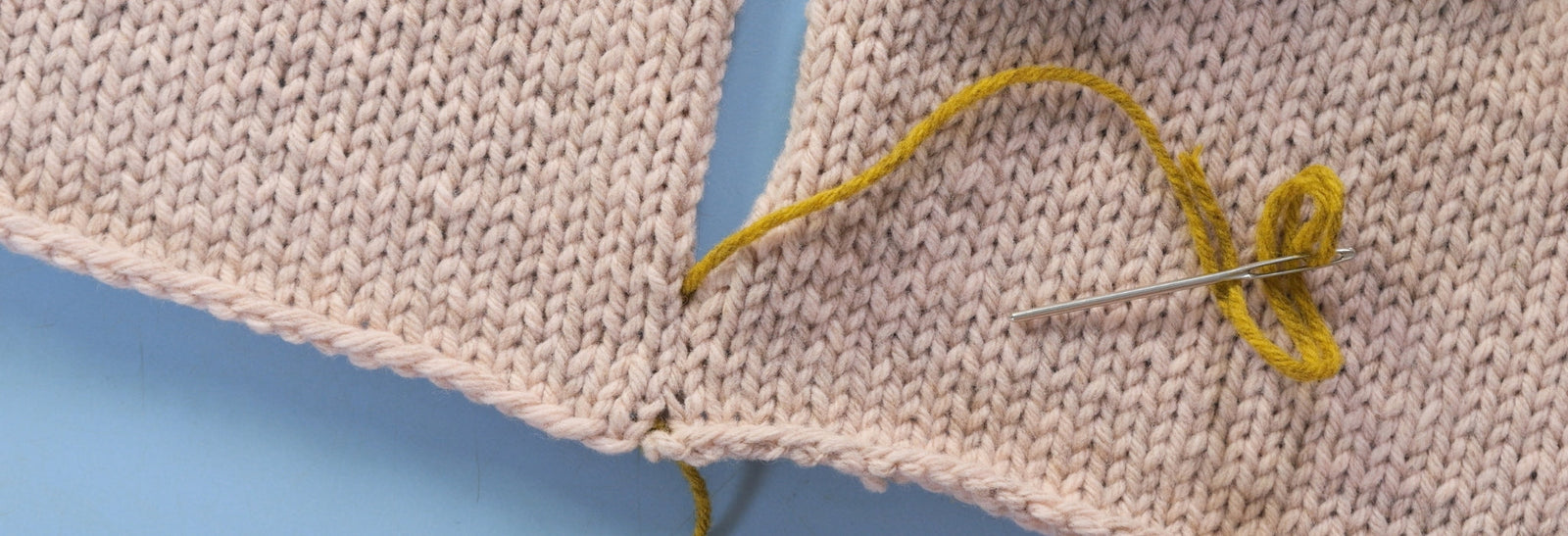Your Cart is Empty
KNITSONIK Stranded Colourwork Sourcebook
October 28, 2014

There are many, many knitting reference books that have wonderful, useful content but which could have been written by anyone with the right skill set and ability to impart information. Those things take hard work and experience, but the books I really care about, the ones that I’ll hang onto despite knowing how to do whatever techniques they cover, are the ones that could not have been written by anyone but their particular author. Not incidentally they’re also the books that tend to divide opinion. Elizabeth Zimmermann’s ‘pithy’ directions started many knitters down a creative path but are unnecessarily perplexing to others. Part of the pleasure of reading Montse Stanley’s or June Hemmons Hiatt’s technique bibles is the internal arguments you get to have with their strong opinions on everything from sleeve cap shaping to holding the needles.
There’s inspiration to be found in unique voices, and those are the books whose teaching goes far beyond specific techniques.
Felicity Ford’s KNITSONIK Stranded Colourwork Sourcebook is such a book. Felicity first crossed my radar years ago when I ran an extremely silly contest to knit my Elijah pattern and create a photo story of his adventures — she got delightfully into the challenge.

Stuffed animals, words no one else I know uses, an enormous sense of fun — things that could so easily be dismissed as childish affectations. And yet, combined with Felicity’s extremely serious approach to her multi-disciplinary and wide ranging art practice, the result is a grounding of big ideas in the everyday earthiness of beer, fruitcake, patches of weeds and, of course, the practise of making something necessary for warmth beautiful that is at the heart of all stranded colourwork traditions.
Whenever I teach there are two questions I dread being asked the most: “how do you find inspiration?” which is really “how should I find inspiration?”; and “how do you put colours together?”. In response I usually mumble something and books and films and architecture and paying attention, or I joke that “inspiration isn’t my problem, it’s finding time to put ideas into practice”. Which is true, but it’s a spectacularly useless response to someone who isn’t feeling inspired or can’t see a path from appreciating the structure of an interesting roof to a lace shawl. As for colour, my knowledge of colour theory began and ended with an argument with a teacher who told me I didn’t need the requested purple paint because I had blue and red. She refused to believe that that particular blue and red would make brown, whatever the rule was.

Both the ability to pick out interesting details and imagine how they can be re-interpreted and a good sense of colour can seem like innate qualities, rather like perfect pitch (guess which of these I don’t possess at all!). To a certain extent I’m sure they are, but that doesn’t mean that they cannot be developed through structured practice. Felicity’s formal art training (and teaching) is clearly evident in her approach to developing a clear, step-by-step system that emphasises the importance of playing with ideas, critical review and creative constraints. Some readers will follow this approach more strictly than others, and the book explicitly acknowledges that they are simply the rules and limitations that have helped Felicity’s process. Encouraging readers to “hack the system” she says, “I’m giving you my map and compass, but this should be your adventure.”

The book begins with a general overview of this system including basic tips for making charts and working stranded colourwork. Outlines are given for developing both initial charts and colour palettes but the emphasis is on working out those ideas while actually knitting. We often see swatching as a preliminary chore done, if at all, as a necessity to ensure the real knitting turns out properly. I find even many working, or aspiring, designers feel like time spent swatching is wasted when their ideas don’t work out as planned. Here swatching becomes a crucial part of the creative process, an approach that Felicity describes as removing “the fear of getting things wrong, because when learning through trial and error, mistakes are completely welcome”. It sometimes feels like I spend ninety percent of my knitting time on swatches or sections that are eventually ripped out, so it was personally nice to be reminded of how important that is. We could all do with giving ourselves the time, space and to play in this way and the warm-hearted generosity towards mistakes that Felicity constantly demonstrates. That, more than any of the actual examples, may be the most inspiring element of the book.

There are, however, specific examples, and plenty of them. The main part of the book is divided into three sections: A World Full of Things, A World Full of Places and A World Full of Plants. Each illustrates the process of finding inspiration, creating a palette and patterns and developing a shading scheme while swatching. The descriptions of things and places are highly particular and personal, to an extent that initially seemed somewhat out of place in a book on knitting. As I continued to read however, I found myself enjoying these descriptions for themselves, and appreciating how much they illustrated the practice of observing the things we love for reasons far beyond the fact that they’re pretty. In fact, the examples I found most interesting began with the least obvious, least pretty, sources of inspiration like driving on the motorway or functional objects.


In a world where it often seems like inspiration and creative work is trapped in an endless self referential loop as everyone looks at the same things on Pinterest or Ravelry it’s rather refreshing to see explicit examples of going out into the world and observing. Inspired by the ways in which stranded colourwork traditions in Estonia and Shetland are rooted in their cultures and landscapes the book is part of a wider mission to encourage knitters to develop their own such traditions, and in so doing, to become more connected with their own surrounding places and communities:
“I hope that reading and knitting from it will help you to hear yourself more clearly in the din of the modern world, and to notice and discover all the latent treasures where you are.”
It’s a fabulously expansive attitude towards a knitting technique that can often feel artificially constrained by traditions that were never set in stone anyway.
Each of the three chapters follows the same format, and includes some repeated information. Reading cover to cover this is mildly annoying but, on balance, I think that will be a useful benefit as it makes it easier to pick up and use at any point.

Charts are included for the most successful ideas generated in the chapters and the final chapter, From Swatching to Wearing, demonstrates how to put these and the reader’s own patterns to use. This clearly written guide will be sufficient to inspire experienced knitters without going into overwhelming detail — references are included for those who want to learn more about garment design. The focus is on the particular constraints on stitch counts and shaping posed by stranded colourwork patterns. Two master patterns are included, for fingerless mitts and legwarmers, and the process of applying different colourwork patterns to these is shown from beginning to end in case studies. Like the entire book, the approach here is “this is how I did it, now try your own” and full fill in the blank charts are included for these projects.

Two versions of the mitts pattern and the objects they were inspired by: the plants and brickwork found on Felicity’s home street and a 1930s book about electricity. These show the rather quirky nature of her design process with the pattern placement depending on the desire to position the battery design over the pulse point on the wrist.

This is not the first knitting book, or yarn industry business development I’ve seen seeking crowd funding but it may be the one that I felt was most suited to the model. I have a lot of complicated, and conflicting, thoughts on the rise of crowd funding but they can probably be boiled down to — “will this create something of benefit to the funders and wider community and wouldn’t otherwise exist?” As the enthusiastic campaign, and response now the book is available, have demonstrated the answer to that question is a resounding yes.
Of course there are other publishing models, and some excellent traditional publishers and editors working on knitting books are out there, but I can’t help but think that if it hadn’t been self published this book would have lost some of what makes it so special. I suspect the very personal, specific descriptions of places and objects would have been cut down, made more picturesque, less cheery. More patterns would have been insisted upon, at the cost of space to encourage readers to give things a try for themselves. It might have been a good and useful book, but I’m not sure it would have been nearly such a great one.

The Stranded Colourwork Sourcebook shows self publishing at its best, and is part of an increasing family of self published knitting books that are not instantly recognisable as such. Photography is crucial to a book about colour and the images shot by Felcity’s brother Fergus, are both clear and appealing and the credit’s emphasise the value of working with your community: “Ferg’s photos reveal that sometimes he understood this project better than I did.”

The layout is clear and professional, at its best in the main chapters where the swatches are given space to breathe. I did find myself wishing the pages of charts had been less crowded, and had wider margins on the spine side — it gets a bit hard to read everything without breaking the spine of the book. Separating the illustrations of the system in practice from the secondary material of the charts is a logical decision but I would have liked to see them more clearly linked. This may be somewhere where having the ebook available to work from (I was delighted to see that this is available for free to everyone who buys the print version, something I do myself and feel strongly is the way of the future) is very useful. Readers might want to position the charts for each theme together with the large images of the swatches for the sake of comparison.
I was mildly curious about what this book would turn out to be, but the fact that it’s something I needed to fill a gap in my knitting library I didn’t even realise existed, was a pleasant surprise. Felix has achieved something remarkable that should be essential reading for anyone interested in making their knitting more creative, a book that in its very specificity becomes generally inspiring in a way that will go far beyond stranded colourwork.
As soon as my copy of the book was delivered to the studio Bex grabbed it but, overwhelmed by flicking through she deemed it necessary to order her own in order to spend the time with it that it demanded. I think you’ll feel the same way, and the book can be ordered directly from Felicity here. She’s also generously given me a copy to send to one lucky reader. To be entered into our prize drawing please leave a comment describing what place or object in your life you’d like to turn into stranded colourwork patterns. Leave a comment before Thursday and Felicity we’ll post a winner in the guest Technique Thursday post that she’ll be doing — I’m rather excited to share that!

Also in Journal

Learn to Knit: Mattress Stitch
March 29, 2023
By following our step-by-step mattress stitch knitting tutorial, you'll learn how to make your seams look beautiful and how best to prepare your knitting so that when you seam it with mattress stitch, it goes smoothly on the first try.
Read More
How to Knit a Scarf: A Beginners Guide to Scarf Knitting
March 23, 2023
Want a quick and easy beginners tutorial on how to knit a scarf? This garter stitch scarf is easy to knit and requires just 3 skills; casting on, the knit stitch and casting off.
Read More
Learn to knit: the long tail cast-on
February 03, 2022
The long tail cast on is a great multi-purpose knitting cast on and the perfect place for beginner knitters to start. Learn how to work the long tail cast on and how to estimate the length of yarn needed with our clear step by step tutorial and video.
Read More Recent Articles
- Learn to Knit: Mattress Stitch March 29, 2023
- How to Knit a Scarf: A Beginners Guide to Scarf Knitting March 23, 2023
- Learn to knit: the long tail cast-on February 03, 2022
- How to Kitchener Stitch December 09, 2021
- Crochet Provisional Cast-on December 02, 2021
- Learn to knit: How to knit in the round with double pointed needles November 25, 2021
- Learn to knit: How to knit in the round using the magic loop technique November 25, 2021
- Learn to knit: How to knit in the round November 25, 2021
- Knitted Gift Ideas for you and your loved ones November 18, 2021
- Celebrating our Porty Hat Preview Knitters October 28, 2021
Free resources
-
KALS, step-by-step pattern guides and free patterns
Learn brioche with the free Daniel's Hat pattern
Tombreck - a free chevron beanie pattern
Working the brioche neck detail on the Polwarth sweater
Basics
Casting on
Decorative Channel Island Cast-on
Binding off
3 Easy Stretchy Bind-offs (p2tog bind-off; k2togtbl, k1 bind-off; Jeny's surprisingly stretchy bind-off)
Tubular Bind-off for brioche stitch
Increasing
Paired increase methods compared
Decreasing
Brioche stitch double decreases
Knitting in the round
How to Knit in the round using Magic Loop
How to Knit in the round using DPNs
Short rows
Swatching and gauge
Tips and tricks
Avoiding ears when binding off
Tighter purl stitches for neater cables and ribbing
Cabling without a cable needle
Reading knitting patterns
Understanding "continue in pattern"
Finishing
Garment knitting
Joining the body and sleeves on a seamless bottom up sweater
Sizing
Inclusive garment knitting
How to pick a garment without a model for you (specifically addresses finding garment patterns when your gender identity isn't represented and the styles you want to knit might not be sized to fit your body)
How does ease affect inclusive size ranges?
Specific stitch patterns
Lace
Identifying and fixing mistakes in lace knitting
Colourwork
Getting started with stranded colourwork
Understanding colour dominance
Working stranded colourwork over small circumferences
Decreases in stranded colourwork
Holding the yarn for stranded colourwork
Ladderback Jacquard (a neat way to deal with long floats)
Cables
Cabling without a cable needle
Cabling without a cable needle on the wrong side
How to knit cabled decreases
Closed ring cable increases and decreasesBrioche
How to work brioche stitch in the round
Other crafts
Cross stitch
How to begin your first large cross stitch project
How to finish a cross stitch project with an embroidery hoop frame
Mending

Sign up today
Find out the latest news from the studio such as sales, pattern releases, and new workshops or KALs our learning community, The Knitwork. We also share helpful tips and exclusive subscriber discounts...

